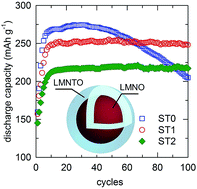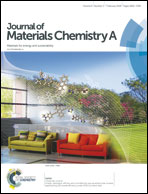Synergic coating and doping effects of Ti-modified integrated layered–spinel Li1.2Mn0.75Ni0.25O2+δ as a high capacity and long lifetime cathode material for Li-ion batteries†
Abstract
An integrated layered–spinel material with a nominal composition of (1 − x)Li1.2Mn0.6Ni0.2O2·xLiMn1.5Ni0.5O4 (0.15 < x < 0.3) and crystal defects has been found to be a promising cathode material with a high capacity of 280 mA h g−1. However, capacity fading arising from Mn2+ dissolution occurred at low voltages and long cycling times. To improve the cycling stability while preserving the advantages of this cathode material, a synergic coating and doping approach was studied. This method yields a coating with a similar, but more stable, structure to that of the pristine sample. This coating is achieved by the bulk doping of the surface while maintaining the ratio of layered to spinel phases. The coating layer had a thickness of 12 to 18 nm, which increased with increasing Ti doping, and protected the sample at low voltages while maintaining the ion and charge transport channels on the surface. The Ti-doped sample enhanced the capacity retention by up to 97% after 100 cycles at C/10 and 89% after 200 cycles at 1C compared to 75% and 74% of the pristine sample, respectively. The optimized sample delivered a stable capacity of 270, 250, and 145 mA h g−1 at C/20, C/10, and 1C respectively. This study provides an effective approach to improve the cycling performance of integrated spinel-layered cathode materials.



 Please wait while we load your content...
Please wait while we load your content...